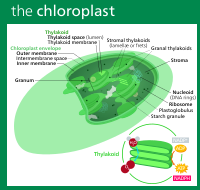
Photo from wikipedia
Abstract Many photosynthetic species have evolved CO2-concentrating mechanisms (CCMs) to improve the efficiency of CO2 assimilation by Rubisco and reduce the negative impacts of photorespiration. However, the majority of plants… Click to show full abstract
Abstract Many photosynthetic species have evolved CO2-concentrating mechanisms (CCMs) to improve the efficiency of CO2 assimilation by Rubisco and reduce the negative impacts of photorespiration. However, the majority of plants (i.e. C3 plants) lack an active CCM. Thus, engineering a functional heterologous CCM into important C3 crops, such as rice (Oryza sativa) and wheat (Triticum aestivum), has become a key strategic ambition to enhance yield potential. Here, we review recent advances in our understanding of the pyrenoid-based CCM in the model green alga Chlamydomonas reinhardtii and engineering progress in C3 plants. We also discuss recent modeling work that has provided insights into the potential advantages of Rubisco condensation within the pyrenoid and the energetic costs of the Chlamydomonas CCM, which, together, will help to better guide future engineering approaches. Key findings include the potential benefits of Rubisco condensation for carboxylation efficiency and the need for a diffusional barrier around the pyrenoid matrix. We discuss a minimal set of components for the CCM to function and that active bicarbonate import into the chloroplast stroma may not be necessary for a functional pyrenoid-based CCM in planta. Thus, the roadmap for building a pyrenoid-based CCM into plant chloroplasts to enhance the efficiency of photosynthesis now appears clearer with new challenges and opportunities.
Journal Title: Plant Physiology
Year Published: 2022
Link to full text (if available)
Share on Social Media: Sign Up to like & get
recommendations!